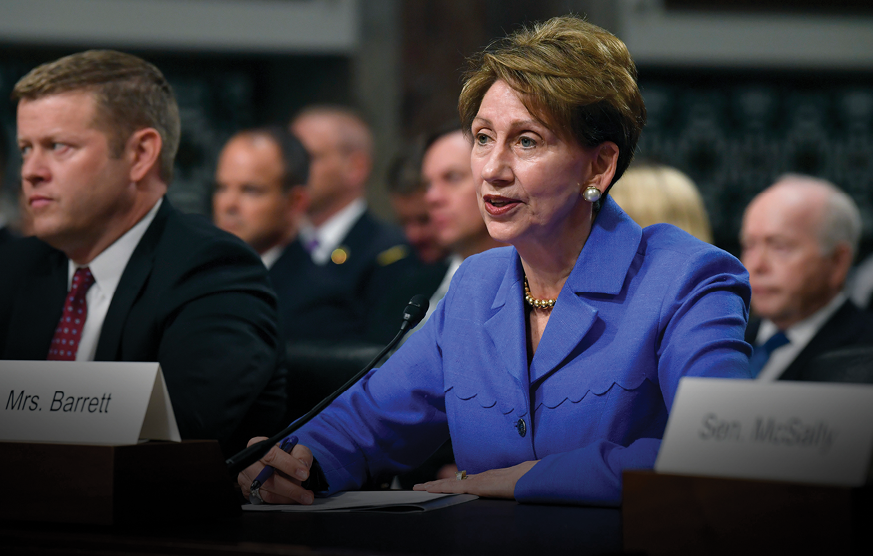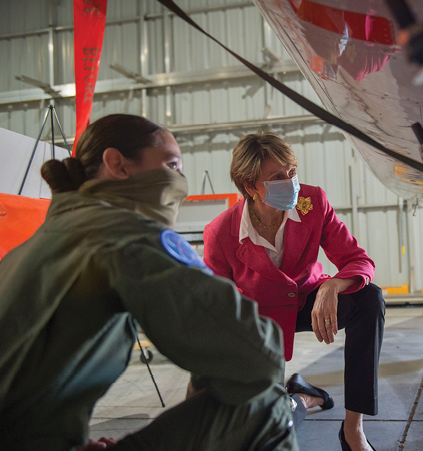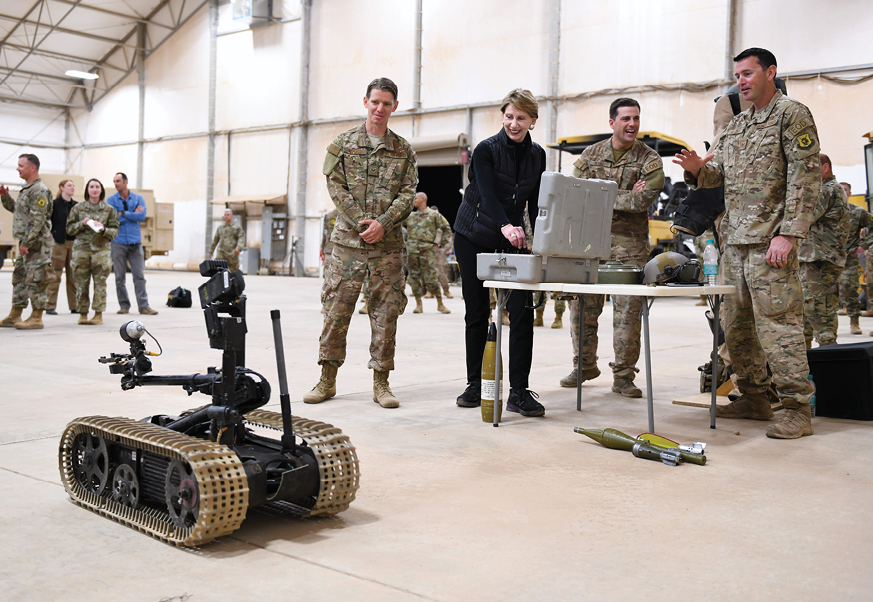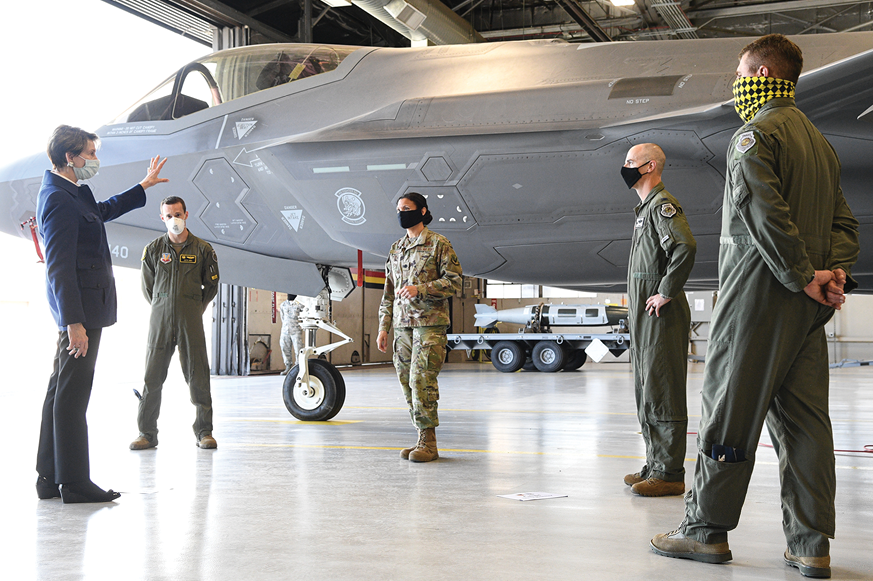- Home
- Media Kit
- Current Issue
- Past Issues
- Ad Specs-Submission
- Ad Print Settings
- Reprints (PDF)
- Photo Specifications (PDF)
- Contact Us

![]()
ONLINE

A Duty to Serve
Editors’ Note
Barbara Barrett is the 25th Secretary of the Air Force and leads the affairs of the Department of the Air Force, comprised of the U.S. Air Force and U.S. Space Force. Barrett has served in senior leadership positions in public service, the private sector and academia. Before she was 30, she was an executive with two global Fortune 500 companies. Her key leadership roles include time as the U.S. Ambassador to Finland, Deputy Administrator of the Federal Aviation Administration, and President of the Thunderbird School of Global Management. She also taught leadership as a Harvard Fellow at the Kennedy School of Government. Prior to assuming her current position, Barrett was the Chair of the Board for the Aerospace Corporation. She has served as a board member for multiple organizations focused on diplomacy, defense, aeronautics, science and space. She was a Senior Advisor to the U.S. Mission to the United Nations, a member of the Defense Advisory Committee on Women in the Services, the Defense Business Board and the U.S.-Afghan Women’s Council. She has chaired groups that include the U.S. Advisory Commission on Public Diplomacy, the U.S. Commerce Secretary’s biennial Export Conference and the U.S. Department of State’s Women’s Economic Empowerment Working Group. She is an instrument-rated pilot and was trained and certified for space flight. Additionally, she has been a cattle and bison rancher for close to three decades. Barrett earned her bachelor’s, master’s and law degrees at Arizona State University.

Secretary of the Air Force Nominee Barbara Barrett
testifies before the Senate Armed Services Committee
as a part of the confirmation process on
September 12, 2019, in Washington, D.C.
What interested you in accepting this role directing a branch of the military?
I recognize the extraordinary privilege it is to lead the 693,000 men and women serving the United States as Air and Space Professionals. In keeping with America’s core doctrine of civilian leadership of the military, the United States Air Force and United States Space Force operate under the leadership of a civilian Secretary of the Air Force appointed by the President and confirmed by the U.S. Senate. Throughout my career in private business, academia and diplomacy, I have admired the men and women who commit their lives to preserve and protect the United States Constitution and American people. Beginning as a student intern in the Arizona State Legislature, I have been conscious of the importance of serving in our government if asked. So when I was asked to serve as Secretary of the Air Force, I felt a duty to serve.

1st Lt. Hannah Myers of the 586th Flight Test Squadron
gives Secretary Barrett a close look at a T-38A Talon
on May 20, 2020, on Holloman Air Force Base, New Mexico.
Secretary Barrett visited facilities on base to interact with
Airmen who have been working diligently to adapt, innovate
and still complete mission operations amid COVID-19.
What have been the keys to your success and ability to lead throughout your career?
To the extent I have found success, the keys have always been talented, dedicated colleagues who team up to achieve success.
How do you define resilience and how critical is resilience when serving in the Air Force?
One definition of resilience is the capacity to recover quickly from difficulties. Accepting that definition, the men and women of the Air Force and Space Force demonstrate resilience more than almost anywhere in society. Our Air and Space Professionals embody resilience in achieving feats of extraordinary difficulty from flying and maintaining the fleet of fighter, bomber, tanker, transport and other aircraft to launching and operating sophisticated satellites.
“Our Air and Space Professionals embody resilience in achieving feats of extraordinary difficulty.”
The Air Force has a resilience website dedicated to helping Air and Space Professionals and their families build resilience. Do you feel that resilience is something a person is born with or can it be taught?
Some measure of resilience may be inborn, but to a greater extent, it seems to be a learned capacity. For that reason, the Department of the Air Force offers resources to Air and Space Professionals and their families both for day-to-day life as well as for particularly challenging times.

Secretary Barrett drives a bomb disposal robot used by
the Explosive Ordnance Disposal Team deployed to the
724th Expeditionary Air Base Squadron during
her visit
to Nigerien Air Base 201, Niger, on December 21, 2019. While
at the installation, Barrett learned how each unit supports
the mission from building the future of the base to
defending its assets and personnel.
How has your personal resilience helped to drive your career?
My life was changed profoundly when I was 13. I was one of six siblings living on a remote subsistence farm when my father died suddenly. My younger brothers went to an orphanage, but I stayed on the farm and earned the family income by taking people horseback riding. Lessons learned while facing that experience made subsequent career challenges seem less daunting.

Secretary Barrett speaks with 388th and 419th Fighter Wings
leadership during a visit to Hill Air Force Base, Utah, on April 30, 2020.
COVID-19 has stressed the resilience of the U.S. Armed Forces in terms of the missions the Department executes, its ability to execute those missions, military-to-military relationships, and in many other ways. How has your definition of resilience changed since the onset of COVID-19 and how has the pandemic impacted the Armed Forces?
While my definition of resilience has not changed due to COVID-19, the pandemic has been an opportunity for the United States Air and Space Forces to demonstrate resiliency. At the beginning of the COVID-19 pandemic, American evacuees from Wuhan, China, were housed temporarily at a United States Air Force base while quarantine issues were resolved. Our sister services similarly stepped up early to assist. Navy hospital ships, the Mercy and Comfort, served on opposite American coasts. Army field hospitals were set up to augment civilian facilities. While serving the medical needs of our military men and women, we also continue to serve our military families, communities and nation. Despite the needs driven by COVID-19, the men and women of the military continue to protect the nation.
“Despite the needs driven by COVID-19, the men and women of the military continue to protect the nation.”
Who are some of the resilient leaders you see today?
The new 22nd Chief of Staff of the Air Force, General CQ Brown, exemplifies resiliency. In addition to the predictable challenges of a career flying fighter jets, General Brown encountered adversity through his career because of racial bias. Still, he used the bias he encountered as an incentive to rise beyond expectations. General CQ Brown demonstrates technical expertise gained from serving around the world as well as deep community awareness because of personal experiences through his career. His resilience helped him build the winning combination of both technical and leadership excellence.![]()